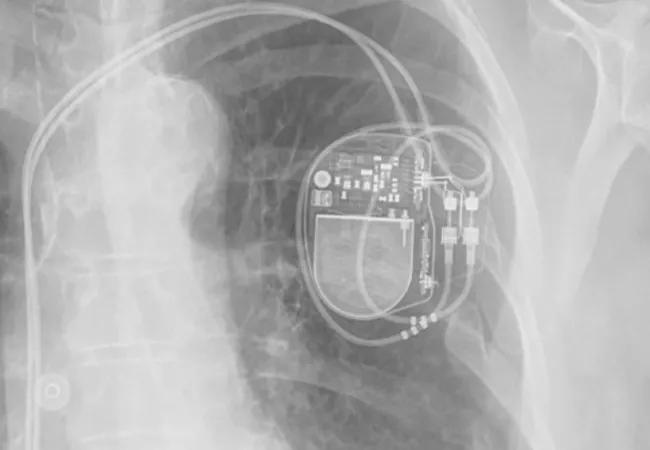Study reveals opportunity to boost outcomes with CRT upgrade

Pacing-induced cardiomyopathy (PICM) will develop in 1 in 8 patients who receive a permanent pacemaker for complete heart block with normal ejection fraction. And an increased right ventricular pacing burden is the factor that best predicts PICM.
Cleveland Clinic is a non-profit academic medical center. Advertising on our site helps support our mission. We do not endorse non-Cleveland Clinic products or services. Policy
So conclude electrophysiologist Daniel J. Cantillon, MD, and a team Cleveland Clinic colleagues in a retrospective cohort study published in the December 2016 issue of Heart Rhythm.
The study also showed there’s an excellent opportunity to reverse these patients’ cardiomyopathy by upgrading to cardiac resynchronization therapy (CRT). “Upgrade to CRT is highly effective clinically, but it is underutilized,” notes Dr. Cantillon.
The researchers conducted their study to characterize the incidence and predictors of PICM in a patient population not adequately studied to date.
“The BLOCK HF trial showed that patients with reduced left ventricular ejection fraction (LVEF) fare better with biventricular pacing than with a single-chamber pacemaker for complete heart block,” says Dr. Cantillon. “But the percentage of patients starting out with a normal ejection fraction who would develop PICM was unknown. We wondered which clinical variables would predict PICM, and what would happen when patients were upgraded to CRT.”
So he and colleagues analyzed consecutive adults undergoing pacemaker implantation for complete heart block at Cleveland Clinic from 2000 to 2014. More than half had developed heart block following a valve procedure. Patients were equally divided between men and women, with a mean age of 68.9 years. All had a normal LVEF (> 50 percent) at the time of implantation and at least one echocardiogram within six months following implantation.
PICM was defined as a subsequent upgrade to CRT or a postimplant drop in LVEF to ≤ 40 percent on echocardiography. “The threshold of 40 percent was carefully chosen to account for inherent margin of error in LVEF estimates by echocardiography and to maximize certainty that reported LVEF decreases after pacemaker placement represented true incident systolic dysfunction,” Dr. Cantillon explains.
Among the 823 patients who met inclusion criteria, 101 (12.3 percent) developed PICM over a mean follow-up of 4.3 ± 3.9 years, with some patients followed for up to 14 years. “This figure of 12.3 percent jumped out at us,” says Dr. Cantillon. “It is not trivial. Moreover, the hazard continued even 10 years out.”
Multivariable regression analysis showed that a right ventricular pacing burden greater than 20 percent was most strongly associated with development of PICM (hazard ratio = 6.76 [95% CI, 2.08-22.0]; P = .002 by categorical analysis). The incidence of PICM increased dramatically at a right ventricular pacing threshold of 20 percent and then again at a threshold of 40 percent. “As the percentage of pacing increased, the hazards of PICM grew,” Dr. Cantillon notes.
The only other variable that independently predicted PICM was a lower pre-implant LVEF (hazard ratio = 1.045 per 1 percent LVEF decrease [95% CI, 1.002-1.020]; P = .021), though it was less strongly associated than right ventricular pacing burden.
Lead positioning was among the other variables examined, with the expectation that lead placement high in the septum would be associated with superior results. No statistical difference was seen between apical and non-apical placement, although apical placement trended toward superiority. “A group at the University of Pennsylvania published a study a couple of years ago with a similar finding,” notes Dr. Cantillon. “The jury’s still out on this one.”
Among the 101 patients who developed PICM, the rate of subsequent CRT upgrade rate was only 28.7 percent. But among those who were upgraded, the echocardiography response rate was an impressive 84 percent, with response defined as an LVEF increase of at least 10 percent or an LV end-systolic volume decrease of at least 15 percent.
“As in previous studies, upgrade to CRT was underutilized, particularly at postpacing ejection fractions of 35 percent or higher,” notes Dr. Cantillon. “This represents an opportunity to further improve outcomes.
“The take-home message is that we should carefully follow patients who are pacemaker-dependent, as right ventricular PICM will affect more than 1 in 8 of them,” says Dr. Cantillon.
“We should be giving them routine echo assessments, even though current practice guidelines say these patients are not candidates,” he adds. “At the very least, we should be following them carefully for signs of congestive heart failure and consider upgrading them to a CRT pacemaker system if their LVEF drops.”
For more commentary on this study from Dr. Cantillon, see heartrhythmjournal.com, where this study is the subject of the “featured article author interview” for December 2016.
Image credit: Cleveland Clinic Journal of Medicine

Surprise findings argue for caution about testosterone use in men at risk for fracture

Findings support emphasis on markers of frailty related to, but not dependent on, age
![GettyImages-1252287413 [Converted]](https://assets.clevelandclinic.org/transform/StoryPanel/350804b2-f1e4-4d97-a277-9629cf45af3e/23-HVI-4120348_redlining_650x450_jpg?w=3840&q=75)
Large database study reveals lingering health consequences of decades-old discrimination

Additional analyses of the two trials presented at 2023 ESC Congress

Prospective SPIRIT-HCM trial demonstrates broad gains over 12-month follow-up

An ACC committee issues recommendations to accelerate sluggish progress

Review of our recent experience shows it’s still a safe option

Machine learning may improve risk prediction and guide therapy